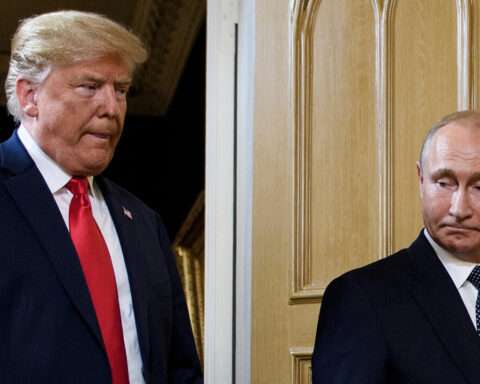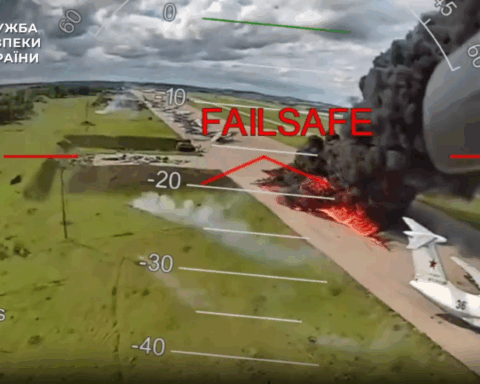Ever since Russian President Vladimir Putin launched a full-scale invasion of Ukraine in February 2022, his armed forces have pounded Ukraine with missiles and drones fired from the relatively safe confines of Crimea.
Following his occupation of the Ukrainian Black Sea peninsula in 2014, the Kremlin leader poured billions of dollars into militarizing Crimea, expanding bases and constructing depots and other infrastructure.
Now fortress Crimea faces a significant new threat that could neutralize its crucial role in the 26-month-old war: U.S. long-range ATACMS, or Army Tactical Missile Systems. After nearly two years of hesitation, the United States earlier this month delivered versions of the powerful ballistic missiles that can travel 300 kilometers — essentially reaching any of the more than 100 military targets on the peninsula.
“The delivery of ATACMS is a big breakthrough. It could basically make Crimea militarily worthless,” Philip Karber, a Washington-based military analyst who focuses on Ukraine.
Crimea is home to Russia’s Black Sea fleet, six air bases, command-and-control centers, arms depots, docks, barracks, and more. It is also dotted with air-defense radars and anti-missile systems to protect the facilities.
Russia regularly fires missiles, including hypersonic ones, and drones from Crimea into southern Ukraine. Lately, it has been pounding the Ukrainian port city of Odesa from the peninsula.
‘An Unsinkable Aircraft Carrier’
Crimea also serves as a key logistics hub for Putin’s war effort. Russia moves critical supplies such as ammunition, heavy armor, fuel, food, and medical equipment from the Krasnodar region to Crimea by road, rail, and ferries and other ships. Much of the supplies and manpower move north through the peninsula into the Russian-occupied parts of the Kherson and Zaporizhzhya regions.
“Right now, Crimea is like an unsinkable aircraft carrier for the Russians, launching drones and aircraft and providing logistical support to their forces in southern Ukraine,” Ben Hodges, a retired U.S. Army lieutenant general who commanded U.S. forces in Europe, told RFE/RL.
Ukraine struck several key military targets on the peninsula –including air bases and the 19-kilometer Crimea Bridge, the only physical connection between Russia and Crimea and a critical military supply route — even before the latest deliveries of ATACMS were approved by the United States on April 24.
Though Russia regularly shuts down the bridge due to threats, Moscow continues to deliver substantial supplies to Crimea across the link as well as via ferries, Karber said. Ships also carry cargo to Sevastopol, the headquarters of Russia’s Black Sea fleet located on the peninsula’s southwest coast.
Zelenskiy for months had been urging the Biden administration to send the longer-range ATACMS, which carry a 230-kilogram warhead, in order to hit military targets far behind Russian lines, especially those in Crimea. Ukraine produces a only small number of long-range missiles, though it hopes to begin ramping up output this year.
The United States last autumn sent a shorter-range version of the ATACMS with a reach of 165 kilometers that sprays bomblets when it explodes. Ukraine successfully used them for the first time in October against targets in eastern Ukraine.
Shortly after receiving the longer-range ATACMS earlier this month, Ukraine on April 17 reportedly used them to strike Dzhankoi air base in northeast Crimea, damaging Russian helicopters, an S-400 strategic surface-to-air platform, the country’s most advanced air-defense system, and an aerospace surveillance complex used as a command-and-control center. The reports could not be independently verified.
The Numbers Game
The United States has not announced how many of the longer-range ATACMS it has already sent to Ukraine or how many more Ukraine could receive in the coming months.
The New York Times, citing unidentified U.S. officials, said more than 100 of the longer-range ATACMS were delivered to Ukraine. Multiple ATACMS may be needed to destroy or severely damage a single target, Karber and Hodges said.
Colby Badhwar, an independent defense analyst, said in a post on X, formerly Twitter, that the United States could plausibly give Ukraine 200 of the long-range ATACMS and possibly more if the roughly 1,140 “expired” missiles in U.S. stocks are still usable.
Ukraine possesses other Western-made missiles though those supplies are dwindling. The United Kingdom last year sent Ukraine its Storm Shadow precision cruise missiles that can hit targets as far away as 250 kilometers. Last week, London announced it would be sending more.
Proof Of Concept
In the span of 10 days in September 2023, Ukraine used its supply of Storm Shadows to hit two targets in Crimea: a shipyard and the Black Sea Fleet’s headquarters in Sevastopol. Ukraine has destroyed or damaged about 24 Russian vessels in the Black Sea — including the flagship Moskva, which was sunk in April 2022 — using a combination of domestic and Western weapons.
Less than two weeks after the strike on the headquarters, Russia withdrew the bulk of its Black Sea Fleet from the peninsula to the Russian port of Novorossiysk.

“The Ukrainians have already proven the concept of what a handful of precision weapons can do against the Russians in Crimea,” Hodges said, referring to the Storm Shadow strikes on Crimea and the subsequent Russian retrenchment.
In an interview with the Washington Post last month, Zelenskiy said the ATACMS would enable Ukraine to drive the Russian Air Force from the peninsula.
“When Russia knows we can destroy these jets, they will not attack from Crimea,” he said. “It’s like with the sea fleet. We pushed them from our territorial waters. Now we will push them from the airports in Crimea.”
Badhwar said ATACMS, which travel at much greater speeds than Storm Shadows and can reach their targets in minutes, are better suited for use against time-sensitive targets like mobile, ground-based air and missile-defense systems, aircraft on the ground, logistical assets engaged in the loading and unloading of supplies, and artillery and missile launchers.
However, he said the German Taurus cruise missile is better suited than ATACMS to target the Crimea Bridge. German Chancellor Olaf Scholz has so far resisted pressure to give Ukraine the powerful missile, though Western officials hope the U.S. decision to supply the ATACMS will force the German leader’s hand.
Nowhere To Hide
Now that Ukraine is armed with ATACMS, Hodges said, there is nowhere for Russian forces in Crimea to hide. Ukraine’s armed forces “know every square meter” of the peninsula, he said. During his visit to the Munich Security Conference in February, Zelenskiy said he showed U.S. officials which targets he wanted to strike with ATACMS.
“The first big step toward the liberation of Crimea is making it untenable. And long-range, precision strike capability will give Ukraine the opportunity to do that,” Hodges said.
“You don’t have to kill all the Russians,” he said. “You just have to make sure that they don’t have fuel, ammunition, and food.”
While Karber said Ukraine would also likely launch ATACMS against Russian military facilities in the occupied eastern parts of the country where Moscow has been making progress and is gearing up for an offensive, Hodges said Crimea is the key to victory.
“Crimea is what we would call the decisive terrain of this board. Whoever controls Crimea is going to be the winner here,” Hodges said.

In the meantime, just isolating Crimea by destroying supply lines would reduce pressure on Ukrainian forces, he added. Russian missile and drone attacks emanating from the peninsula would ease, and Russian troops in the occupied south would face logistics issues, Hodges said.
Ukraine could then potentially free up troops in the south for the tougher theater in the east, he said.
“It will clearly have a broader effect other than just getting the Russians out of there,” Hodges said. “It’ll have an effect across the theater, psychologically as well as logistically and physically.”






